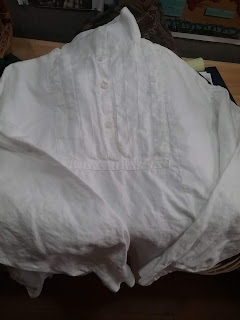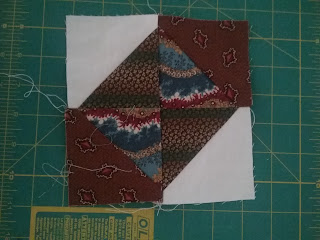I've been musing a bit this summer about how to start conversations with visitors. I find it easy, now, to answer their questions, but when the visitor doesn't make that first overture, it's up to us interpreters to get things rolling. [If the questions you are getting seem less-than-helpful, check out
Liz's post.] Although I'm arguably a professional, what follows are my own thoughts and reflections, rather than a guaranteed method of successfully initiating meaningful conversations. For fair warning, this post has also gotten ridiculously long over the two months I've been re-writing it.
General List of Things That Work
- Greeting the visitor
- Offering an explanation of the activity I'm undertaking
- Asking about the visitor's experiences at the site or event
- Calling artifacts/props to the visitor's attention (in character or in modern voice)
General List of Things That Do Not Work So Well
- Acting scandalized by the visitors' clothing or deportment
- Anything prefaced by "Did you know--"?
- Pretending to be confused by cell phones and similar technology
- Melodrama
- "Do you have any questions?"
Why I Think So
Greeting the visitors is an easy first step. I find a simple "Welcome", or "Good Morning/Afternoon/Day" to be very flexible--"Hi" and "Hello" also work, but for reasons of verisimilitude, I prefer not to use them in my current settings. Sometimes, that's all I need to do--the visitor will offer up a question or observation in response, and we've already begun a conversation. More often, the greeting needs to be followed by one of my other techniques. But, if nothing else, the greeting establishes that I am present, that I am
not a mannequin (which has come up surprisingly often this summer), and that I'm available to talk.
Singing to myself between groups can sometimes accomplish the first two (and amuse me while I wait for visitors), but I need to stop so that a conversation can start.
I'll often combine the greeting with another technique, to give the visitor more bearings about their situation, and provide context to prompt their questions. So, if they've walked in on me doing some work, I'll name the task, and either begin an explanation of it, or beg a moment's indulgence while I set it down. I like to keep these short, and offer succinct facts that help the visitor contextualize what I'm doing, and what additional information they might want. Knitting socks, for instance, might lead into discussion of the people who would be wearing them, the materials they are made from, how I learned to knit, how people made or acquired clothing in the 1850s, how people kept warm in the 1850s. Sometimes, the visitor will offer a statement in return ("My mom used to knit"), as they start to relate your historical pretension to their own lived experience--which is pretty cool and totally what we're about.
Similarly, I can point out an object that may be of interest to the audience, even if I'm not using it. The curtains in the Tolmie house (Damask ordered from England, at a cost of over 5 pounds for 60 yards), is a favorite: it tends to start conversations about trade routes and the availability of goods, but also prompts conversations about social status, wealth, and currency. In the store, I often overhear visitors reading the explanatory plaque aloud before entering the building; when this includes confusion about an item, I'll prepare to point out the lusterware dishes, Jew's harp (or jaw harp, a small musical instrument), or other object of interest. A favorite variant of mine is to greet the visitor, and suggest all of the things they may be interested in purchasing, as a softened version of an eager salesclerk (most of us react poorly to pushy sales pitches, so keep it light).
After the activity or object gambit (or instead), I'll try to ask the visitor a question; after all, this is a conversation, not a lecture. The idea with asking questions is to get the visitor comfortable talking to you, and to suss out what they want to hear more about--this isn't the place to pop quizzes (more on that later). Likewise, rhetorical questions aren't my favorites, because they don't tend to further the conversation. Answers do.
If I'm early on the itinerary (or just saw the group come in and turn towards my usually-later-in-the-experience station), I might try "Is this your first visit to [site]?" This gives me a chance to drop some necessary background information to first time visitors (such as that we're an HBC trading post, not a military fortress), which will reduce confusion during the rest of the visit. Returning visitors will often venture a remark on how often they've attend/when they were last here (a school field trip 30 years ago, the last living history event, the fundraiser concert a few years back), which gives me an opportunity to thank them, and to single out some attractions that may be new since their last visit, or special activities that are happening today, such as:
- The current temporary exhibit
- The renovation of a [now centerpiece] historic building, which occurred 15 yards ago (we do get visitors in who remember touring with a school group 20 or 30 years before)
- Daily programming, like a visiting artisan's demonstration
- The spaces currently being interpreted (blacksmith shop, kitchen, orchard, woodworking area, etc.), and that these are good places to ask any questions they think of while visiting
- Where the restrooms are (it's a new-ish building)
- Attractions and amenities suitable to the group's interests: a group with young children might be especially interested in the game area; making sure groups with strollers/wheels are finding the ramps, etc.
With children, I might try "Are you having fun?", and when they answer "yes", follow up with "what was your favorite thing you've seen so far?" When they inevitably answer the chickens, or the bastion, or the games, I can validate the response and offer an interesting fact or two. ["Yes, there was one chicken taller than the others. His name is Buster, and he's the rooster.", "This house is also my favorite building. When the Tolmies lived here, all three of their sons shared this bedroom."]
Other favorites include "What do you think of [current building]?", and "Does this [kitchen/bedroom/house] look like yours? (mostly a kid question). I've seen "Where are you folks from?" used very effectively to discuss travel times and transportation in the 1850s, leading into a discussion of the store's clientele, and shipment of goods.
With the exception of "Is this your first visit?" and "Are you having fun?", I try to avoid yes/no questions. A lot of people won't take this as an opportunity to start a conversation, as though they don't want to inconvenience the interpreter. While "Do you have any questions?" seems nice and broad, it's really too broad, and doesn't give the visitor much to work with. When I've used it, I usually get "we're just looking", or "not really", which ends the conversation instead of starting it. The people who have questions will manage to ask them. If you must include it, establish the connection and conversation first, so that "Do you have any [more] questions" serves as a bridge between your proposed topics and the visitor's.
On the subject of other questions to avoid, I find "Did you know [fact]" to be inelegant, at best. At worst, it can alienate your audience and undermine your credibility. If you pick an obscure fact, the visitor may feel stupid or isolated; pick an easy one, and you're insinuating that they are ignorant; get it wrong, and you've absolutely destroyed any trust they had in you. This can also happen if the 'fact' appears to reveal an agenda, or offers a overly-simplified view of a complex situation. [If you start a conversation with me by saying, "Did you know the Civil War was actually about states' rights?", you've just seriously undermined my trust in any information presented at your site.]
Other less helpful tactics includes haranguing the visitors about their modern clothing, and fussing about modern devices. Getting the vapors from women wearing pants may successfully convey the idea that women in the 1850s wore dresses (with bonus points for miasma theory). You also just put your visitors on the defensive, making them less likely to ask questions or otherwise interact with you. Really, any verbal prodding or teasing needs to
prodding back--used on a case-by-case basis where the visitor has already indicated that this is how they want to communicate. Getting back to the dress example, I have seen and played with a few variations on the theme of pants and dresses--taking the visitors for dress reformers, or trail emigrants, or simply people who must be here to buy fabric--but I try to keep it non-confrontational and focused on the information content. Less "Women in trousers! I will avert my eyes from this immodesty!", and more "Ah, you must by disciples of Mrs. Bloomer, or perhaps have adopted this costume for ease of travel. If you are looking for dress goods, we have a large selection of cotton prints and delaines..." Even so, this method can be hit-or-miss. Use with caution.
Time spent pretending you don't know what a cell phone is, is time in which you are not talking to the visitor about the year you are trying to interpret. Except for the youngest children, the visitors already know cell phones didn't exist in the year 1855, and belaboring the point isn't adding anything to that knowledge. You will get people trying to 'trip' you up on occasion--I usually respond by answering a related, sincere question (
Liz's post again). So, if they bring up cell phones, I might talk about telegraphs, letters, and the amount of time it takes to communicate across distances. If I'm not in first-person, I might mention that telephones are over two decades in the future (and portable ones over a century). If someone's really being snarky while I'm in character, I'll give them a smile and parse the Latin or Greek roots of the word ("Telephone--sound at a distance? That could be extremely useful, unless it's just a fancy term for 'shouting'.").
Melodrama wastes everyone's time. Even if you find a receptive audience, we mostly aren't professional actors, and we aren't working from professionally written scripts--there are plenty of media options which do it better. The strength of living history lies in truth, and in the specific details we can present to the public. Let's focus on what we can uniquely do well, instead of mediocre dramatics.
Making stuff up? Just NO. Say that you don't know. Refer them to another person or a reference book. Validate the question and express interest in figuring it out. Answer the nearest related question you can. Offer what relevant information you do have. Retreating in shame and horror isn't very welcoming, but it's less of a disservice than lying to people who are trusting you.
I'd also advise against co-opting other people's impressions: talking about what that interpreter over there is doing robs your colleague of the chance to do their own interpreting. Also, they can almost certainly do it better. While I could point out the basics of the carpenter's tools or the blacksmith's forge, the actual artisans can give more detailed and accurate information, as well as actually demonstrating. I shouldn't spoil their audience. And on the other side, as a textile interpreter, I really don't need another person making up facts about my clothing and crafts. Given the choice between lying to the public or contradicting another interpreter... well, I don't do the former, but we just lost credibility either way.

















